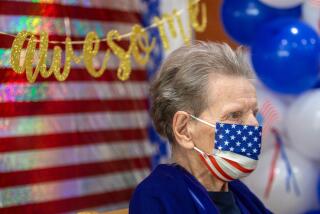Yvonne Pateman, 84; Pilot Served During WWII
- Share via
Yvonne “Pat” Pateman, who earned her wings as a member of the Women Airforce Service Pilots (WASP) during World War II and retired as a U.S. Air Force lieutenant colonel after serving in the Vietnam War, has died. She was 84.
Pateman, who had Parkinson’s disease, died April 4 of a stroke in an assisted-living facility near her home in Leisure World in Laguna Woods.
“I wanted to fly. That’s what I joined to do,” Pateman said of her decision to become a WASP. With the war on, she recalled in a 1996 Los Angeles Times interview, she had no interest in being “a ground-bounder or waffle-butt.”
“My family thought I was out of my mind,” Pateman said.
The youngest of 13 children of a piano-player father and schoolteacher mother, Pateman was born in Seawaren, N.J.
She was working at a Western Electric factory in New Jersey in 1942 when a female co-worker who was taking private flying lessons talked her into going to a small New York airstrip for a plane ride.
Pateman was instantly hooked and used part of every paycheck for her own $10-an-hour flying lessons.
“I lived for flying,” she later told Airman, the U.S. Air Force magazine. “The first time I was ever alone in my life was when I soloed. It was so peaceful.”
A few weeks after her first flying lesson, Pateman saw a newspaper article describing the Women Airforce Service Pilots, a new civilian program under the direction of Jacqueline Cochran, the nation’s top female pilot.
With male military pilots needed in the war zones, qualified women pilots were being sought to ferry the fighters, bombers and transport planes from manufacturers to military bases within the United States. The program gradually would expand to include towing targets for antiaircraft gunnery practice, flying as engineering test pilots and performing other flying tasks.
During a meeting with Cochran in New York, Pateman was offered a spot in the program -- on the condition that she first accumulate 75 flight hours. At the time, Pateman had only six.
Cochran “was looking for someone who had the right mix -- someone with gumption,” Pateman said in a 1991 interview with the Orange County Register. “I borrowed the money from my brothers to get the hours. I was poor and from New Jersey. I didn’t even know how to drive a car!”
Although 25,000 women applied for the WASP training program, only 1,830 were accepted. Of those, 1,074 earned their wings after training at a women-only military flight school, dubbed “Cochran’s Convent,” at Avenger Field in Sweetwater, Texas.
Pateman’s first assignment was at Romulus Army Air Field in Michigan. As a member of the 3rd Ferrying Group, she ferried aircraft from Fort Erie, Canada, to Newark, N.J., where they were shipped overseas.
She later was transferred to Shaw Army Air Field in South Carolina, where she performed “check rides” on aircraft that had undergone repair. “We knew the aircraft, and it was our job to keep ‘em flying,” she told Airman.
Of the 1,074 WASP members, 38 were killed while doing their jobs. Because WASP members were civilians with no military benefits, they would all pitch in to help survivors with burial expenses.
In December 1944, after Congress decided the service of the women pilots was no longer needed, the WASP program was disbanded.
“I went home and they said, ‘Your job is waiting for you at the plant,’ ” Pateman recalled in the 1991 interview. “I couldn’t stand the idea.”
She moved to California, where she landed a job pumping gas at an airport in Monrovia. She was then hired by Aero Trans Inc. in Glendale to fly civilian aircraft from factories to buyers, and she became a flight instructor at Culver City Airport.
In 1949, she accepted a U.S. Air Force Reserve commission as a first lieutenant and was assigned to a Volunteer Air Reserve Squadron.
Called to active duty during the Korean War, Pateman was assigned to the 78th Fighter-Interceptor Wing at Hamilton Air Force Base. Because the Air Force did not have women pilots at the time, she became an intelligence officer and served in the Philippines and Japan.
During the Vietnam War, she was assigned as chief of the 7th Air Force Warning Division from 1969-70 at Tan Son Nhut Air Base in Saigon. Before her 1971 retirement, she was chief of the China Air and Missile Section of the Defense Intelligence Agency.
“Pat Pateman had a path-breaking career in both aviation and the military, fields not traditionally open to women,” said Deborah Douglas, curator of science and technology at the MIT Museum in Cambridge, Mass. “One can’t really imagine how difficult that was.”
Douglas, who included Pateman in her recent book “American Women in Flight Since 1940,” said that unlike other women who served their country during the war, Pateman “was in the vanguard of women who came out of the World War II experience and did not go back to the, quote, normal, expected roles of women in the society.”
Douglas said Pateman was “very conscious of her status as a role model for young women in the military, as well as being supportive of efforts of historians and journalists.”
Pateman was a frequent speaker at aviation and military women’s organization events. She also wrote a 1996 book, “Women Who Dared,” the first history of American women test pilots, and produced a classroom video, “We Were WASP.”
Pateman was a longtime board member of the Women in Military Service for America, which raised money for a memorial to military women, including the WASP, at the entrance of Arlington National Cemetery.
She served 10 years as the WASP chair for Military and Veterans Affairs and was a national president of the Women Airforce Service Pilots Assn. She also was instrumental in the preservation of WASP records, which are now housed at Texas Woman’s University in Denton.
In 1977, Congress passed a bill introduced by then-Sen. Barry Goldwater (R-Ariz.) that made former WASP members eligible for Veterans Administration benefits. According to Douglas, Pateman was a leader in “making sure all living members of the WASP filled in the appropriate forms and papers that got them into the [VA] system.”
Pateman is survived by her longtime companion, retired Air Force Maj. Martha N. Stanton, and 20 nieces and nephews. A memorial service is pending.
More to Read
Sign up for Essential California
The most important California stories and recommendations in your inbox every morning.
You may occasionally receive promotional content from the Los Angeles Times.













